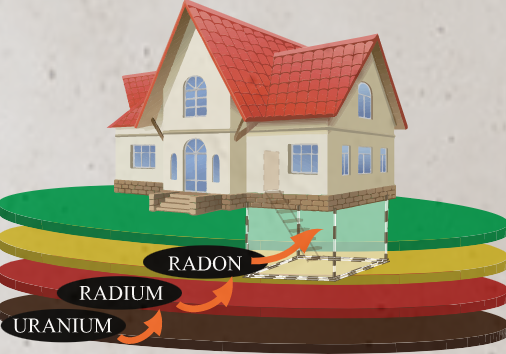Radon is a gas that is colorless, odorless, tasteless, and radioactive. This gas is found in soil and rocks and produced from the decay of naturally occurring uranium. The American Lung Association states that indoor radon is the second leading cause of lung cancer in the United States even among non-smokers.
The Indiana State Department of Health published a healthful booklet with the help of the American Lung Association titled, “Radon & You”. The information provided by this agency is very helpful.
Here is more information to protect your family, friends, schools, and businesses from this harmful gas.
Where is radon found?
Radon can be found in every state inside homes, schools, and businesses. Outdoor levels are typically low, but indoor levels can be very high within the closed space. Levels of Radon gas are independent of building and home structure, and the only way to know the level of the harmful gas is to conduct either short and long term testing.
How can you test for radon before it is too late?
Short-term, inexpensive testing can be in 2-90 days. Short-term and long-term testing kits are often offered by the state or county public health departments. Licensed radon measurement professionals are also available to preform testing for your home, school, and business. The test results provide the level of radon in picocuries per liter (pCi/L). A picocurie is one trillionth of a curie. A curie is the standard unit of measurement for radioactivity in the environment. Levels below 4.0 pCi/L are safe while levels greater than 8.0 pCi/L are recommend for a mitigation system to be installed to reduce levels.
The following chart summarizes the radon test results and the recommended future action:
| Below 4.0 pCi/L | Consider performing a long-term test or re-test in two years. |
| Between 4.0-8.0 pCi/L | Follow up with another short term or long-term test. If the average of the test is greater than 4.0 pCi/L mitigation system installation to reduce levels is recommended. |
| Greater than 8.0 pCi/L | Follow up with another short-term test. If the two tests are in agreement, it is highly recommended that a mitigation system be installed to reduce levels. |
It is also recommended to perform testing every two years or after renovating your home, school, or business to ensure a safe radon concentration level.
Who is at risk?
Everyone is at risk of Radon exposure which is a cause of lung cancer. Although smokers who are also exposed to elevated levels of radon have a much larger risk of developing lung cancer, nonsmokers are also at risk. The odds of developing lung cancer from living with a radon level of 4.0 pCi/L are equivalent to dying in a car accident. The EPA reports that more than 21,000 deaths per year are caused by radon, almost 3,000 of those deaths in non-smokers.
What is your risk?
The map below is the portion of the U.S. EPA map of radon potential levels. Although the map includes potential levels of radon, elevated radon levels have been reported in every county. Testing is recommended for your homes, schools and businesses if there is any question or concern regarding the radon level in a particular facility. Remember that the only way to determine actual, specific radon levels for a particular facility is through sampling and laboratory testing.
